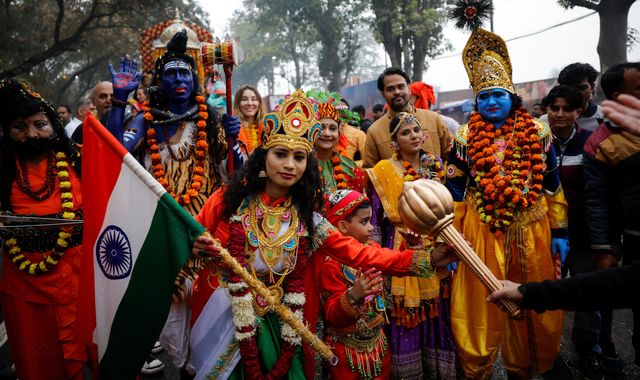Over the next 45 days, an estimated 400 million Hindu pilgrims will converge on the city of Prayagraj, in the northern state of Uttar Pradesh.
The Maha Kumbh mela is one of the most sacred pilgrimages for Hindus and is celebrated once every 12 years.
It is held on the banks of the Ganges and Yamuna and where the two rivers meet.
Pilgrims from all sections of the faith will take part, including Sadhus and Sadhvis (religious men and women), and ascetics and hermits who leave their seclusion only during the Maha Kumbh mela.
For pilgrims, the Maha Kumbh mela serves as a symbolic journey of self-realisation, purification and spiritual enlightenment.
A ritualistic dip in the sacred rivers is a spiritual purification, a symbolic cleansing of the body and soul and renews the connection with the divine.
Security, toilets and tents
To facilitate this mega event a pop-up tent city over 10,000 acres has been set up as a new district – the Mahakumbh Mela District.
More than 160,000 tents have been pitched to accommodate hundreds of thousands of people.
Temporary roads of about 400km (248.5 miles) and 30 pontoon bridges over the two rivers have been laid as well.
Meanwhile, electric substations, police stations, clean water supply lines, 150,000 toilets and over 200km of sewage lines have been constructed too.
Water quality monitoring systems have been installed along the river banks to track pollution in real-time, ensuring that the Ganges remains safe and clean for ceremonial bathing.
Hundreds of doctors and nurses have been drafted in and a 100-bed central hospital and two 20-bed secondary hospitals have been set up.
Special trains, extra flights and public busses have all been laid on for the event.
Security will be overseen by a 50,000-strong police force aided by thousands of AI-enabled cameras and drones for aerial surveillance.
Managing such a crowd requires meticulous planning supported by cutting-edge technology.
Radio Frequency Identification wristbands (RFID) and mobile apps will track the headcount of pilgrims and provide real-time data on crowd density, behaviour analysis, and alert systems in potential high-risk zones.
For the first time at such a large scale facial recognition technology and biometric identification will play a pivotal role in ensuring safety and security.
Pilgrims’ data will be registered allowing authorities to identify individuals and track missing persons.
There are six auspicious days across the festival and five million people are expected to take a holy dip on each of these days.
It’s reported an estimated $815m (£661m) has been spent on the event.
Health and environmental impact
Health activists have raised concerns about the impact of such a large gathering.
Poor conditions in the winter expose people to health risks including contagious disease, and respiratory, faecal-oral, vector-borne, zoonotic and blood-borne contamination.
Other air-borne infections like tuberculosis, influenza and meningococcal disease also have the potential to spread quickly during the mass-gathering.
Read more from Sky News:
Britain’s gas storage levels ‘concerningly low’
Baby born on packed migrant boat
Police search for missing sisters
Communicable diseases pose a threat to global health due to international connectivity, primarily through air travel as experienced during the COVID pandemic.
There is also concern about the environmental impact as the large crowd will generate a staggering amount of pollution on land and water including non-degradable plastics.
Inefficient collection and improper disposal will have an effect on the surrounding areas and landfills.
Mass bathing gives rise to pollution that causes a decline in dissolved oxygen levels harmful to aquatic life.
Construction activities on the river can damage its banks and divert the waters, affecting spawning grounds for fish.
The use of chemical pesticides to control insects during the event can further harm aquatic biodiversity.
Naga Sadhus
The Maha Kumbh mela is a kaleidoscope of people from all walks of life.
But it is the Sadhus (Hindu holy men) that will be the centrepiece of the celebrations.
In particular, are the Naga Sadhu’s – revered individuals known for their intense spiritual practices and complete renunciation of worldly possessions.
Braving the cold winters in little or no clothing they cover themselves in ash as an adornment.
Their presence adds a mystical dimension as they have the privilege to lead the processions and are the first to take the Shahi Snan (royal bath), a sacred ritual that acknowledges their spiritual importance.
In the past, the order for the Shahi Snan was a friction point.
Several violent clashes occurred between the 13 akharas (schools) over this hierarchy, even resulting in deaths.
The Maha Kumbh mela finds its origins in the ancient Hindu legend of “Samudra Manthan” (churning of the cosmic ocean), in the Rigveda, one of the oldest sacred texts of Hinduism.
The event is a showcase of the government under Prime Minister Narendra Modi.
His muscular right-wing Hindu nationalism with a heady mix of religious identity has won him a third term in office.






























